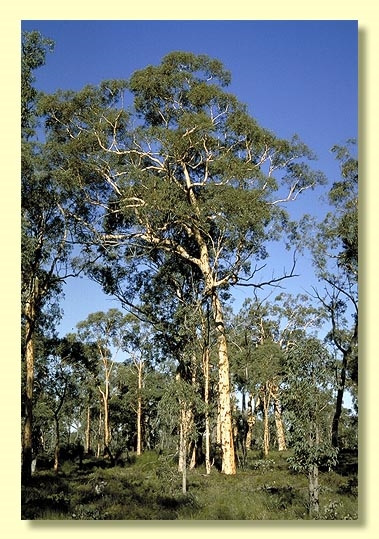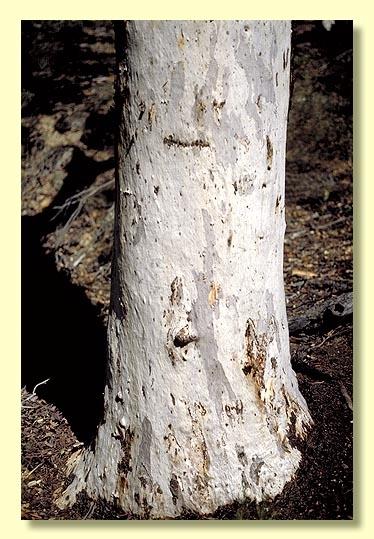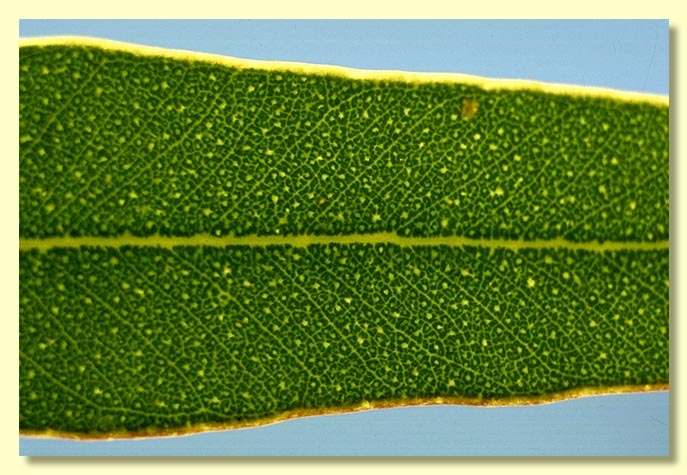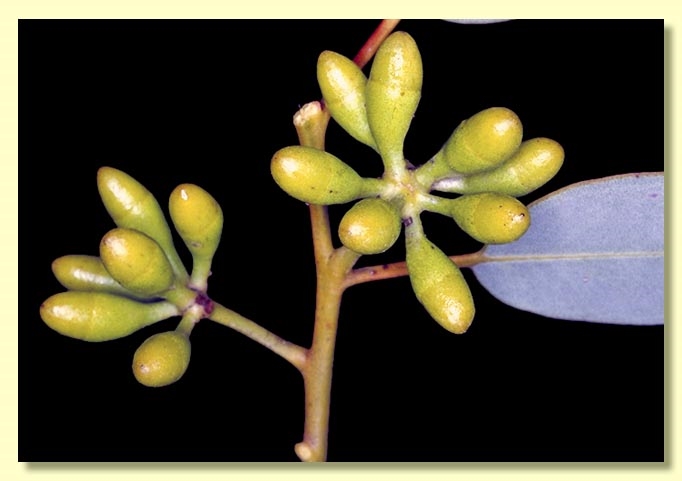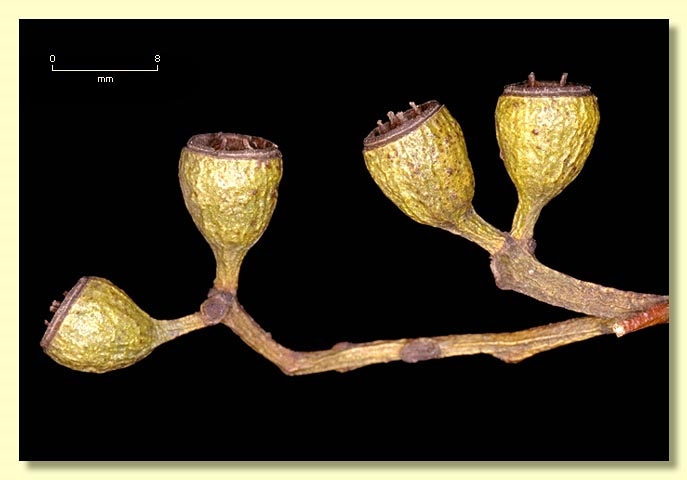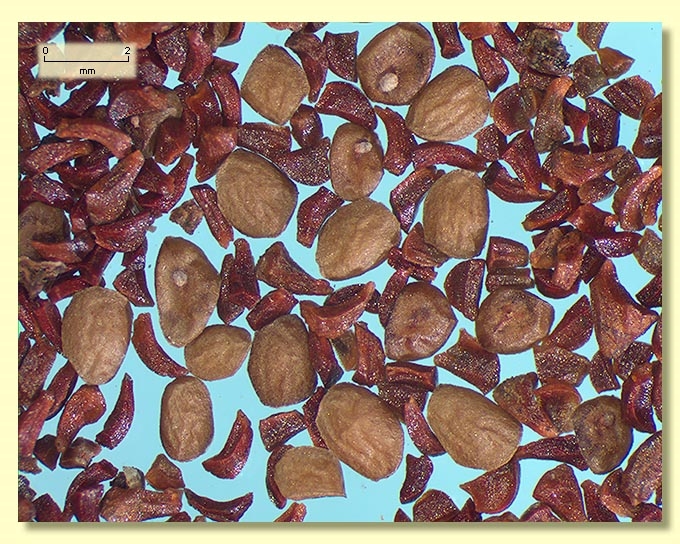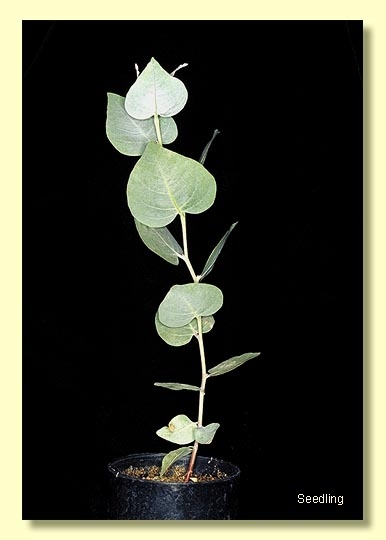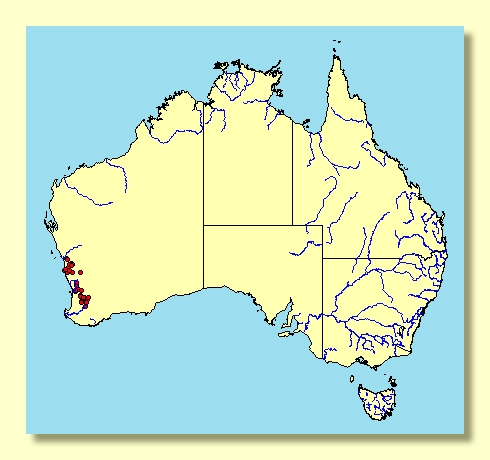Euclid - Online edition
Eucalyptus accedens
Eucalyptus | Symphyomyrtus | Bisectae | Glandulosae | Accedentes
Bark smooth throughout, powdery, white over pale orange to creamy pink.
Branchlets with glandular pith.
Juvenile growth (coppice or field seedlings to 50 cm):stems square in cross-section, often glaucous; juvenile leaves always petiolate, alternate, deltoid, 4–17 cm long, 3–11 cm wide, base truncate or sometimes lobed, margin entire or subcrenulate, apex rounded to broadly pointed, glaucous at first maturing blue-green.
Adult leaves alternate, petiole 1.3–3.2 cm long; blade usually lanceolate, 8–18 cm long, 1.2–3 cm wide, base tapering to petiole or rounded, margin entire, apex pointed, concolorous, dull, blue-green (non-glaucous), side-veins greater than 45° to midrib, densely to very densely reticulate, intramarginal vein remote from margin, oil glands intersectional.
Inflorescences axillary, single, peduncle 0.7–1.7 cm long, buds 7, 9 or 11 per umbel, pedicellate (pedicels 0.1–0.7 cm long). Mature buds cylindrical to obovoid or ovoid (0.8–1.4 cm long, 0.5–0.7 cm wide), scar present, operculum bluntly conical to rounded, rarely apiculate, stamens inflexed, anthers oblong, versatile, dorsifixed, dehiscing by longitudinal slits (non-confluent), style straight, long, stigma blunt, locules (3)4, the placentae each with 4 vertical ovule rows. Flowers cream to yellowy cream.
Fruit pedicellate (pedicels 0.1–0.7 cm long), usually cylindrical to barrel-shaped, 0.6–1.1 cm long, (0.5)0.6–0.9 cm wide, disc descending vertically, valves (3)4, rim level or slightly exserted.
Seed brown, 1.5–2.5 mm long, ovoid or flattened-ovoid, scarcely reticulate, hilum ventral.
Cultivated seedlings (measured at node 10): cotyledons Y-shaped (bisected); stems square in cross-section, glaucous; leaves always petiolate, opposite for 3 to 5 nodes then alternate, cordate to deltoid or broadly ovate, 3–6.5 cm long, 3–6.5 cm wide, sometimes longer than wide, glaucous.
Flowering has been recorded in January and February.
A small to medium-sized tree endemic to Western Australia, found in the Darling Range from about Williams in the south, northwards to south-east of Geraldton, particularly on lateritic breakaways or stony ridges, usually above stands of E. wandoo. E. accedens has white to pink, powdery smooth bark, juvenile leaves which are petiolate, strikingly large (to 11 cm wide), deltoid and glaucous, and dull, blue-grey to blue-green adult leaves.
Eucalyptus accedens belongs to Eucalyptus subgenus Symphyomyrtus section Bisectae subsection Glandulosae because the cotyledons are bisected, buds have an operculum scar and the branchlets have oil glands in the pith. Within this subsection E. accedens belongs to a small subgroup of eight species, series Accedentes, further characterised by having buds with inflexed stamens, ovules in four rows and juvenile leaves petiolate. The species are E. accedens, E. laeliae, E. leprophloia, E. trivalva, E. pruiniramis, E. zopherophloia, E. prominens and E. pilbarensis.
E. accedens is closely related to E. laeliae, which occurs within the broad distribution of E. accedens but is restricted to the western scarp of the Darling Range east and south-east of Perth. E. laeliae differs by having lanceolate juvenile leaves, white or yellow bark in season and smaller buds and fruit. E. accedens is also related to two mallees of restricted occurrence in the northern part of its distribution, E. zopherophloia, south of Dongara, and E. leprophloia, north of Badgingarra, which have rough bark and green, slightly to distinctly glossy adult leaves and do not occur on breakaways. A third related species, E. pruiniramis, a partly rough-barked tree or smooth-barked mallee, differs in having glaucous branchlets, slightly larger fruit and smaller more ovate juvenile leaves. E. pruiniramis occurs on gravelly soils in the Watheroo to Three Springs area.
E. accedens is easily distinguished from other smooth-barked trees in its natural range by its powdery bark that seasonally turns from white to orange and by the juvenile growth, which is usually present in a stand. It is most likely to be confused with the superficially similar E. wandoo subsp. wandoo, which has non-powdery bark and conspicuously fusiform buds (ovoid in E. accedens) with some erect stamens in bud (stamens completely inflexed in E. accedens), smaller juvenile leaves, and occupies nearby sites lower in the landscape.

